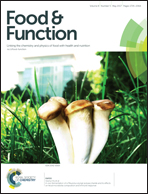Total substitution of dietary fish oil by vegetable oils stimulates muscle hypertrophic growth in Senegalese sole and the upregulation of fgf6†
Abstract
The long term effects of fish oil (FO) substitution by increasing the levels of vegetable oils (VO), 0% (CTR), 50% (VO50) and 100% (VO100), in diets for Senegalese sole were evaluated in terms of skeletal muscle cellularity and expression of related genes. After 140 days of feeding, all fish had similar body weight and length. The inclusion of 50% VO did not result in differences in muscle cellularity, but dorsal muscle cross-sectional area and fast-twitch fibre diameter increased in fish fed total FO substitution, whilst fibre density was reduced (P < 0.05) in relation to CTR. The total number of fibres was similar in all treatments. FO substitution did not affect the transcript levels of myogenic genes (myf5, mrf4, myog, myod1, myod2), but resulted in a two-fold increase of fgf6 transcript levels compared to CTR (P < 0.05). The relative expression of igf-I was higher in VO100 than in VO50, but was similar to CTR. FO substitution resulted in cellularity changes related to the stimulation of muscle hypertrophic growth, but not hyperplastic growth, and associated with a nutritional modulation of fgf6 by dietary VO. This study indicates that 50% VO does not affect the muscle phenotype, but total FO substitution stimulates muscle hypertrophy.



 Please wait while we load your content...
Please wait while we load your content...